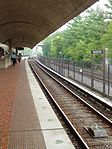Slowe-Burrill House
African-American history of Washington, D.C.Brookland (Washington, D.C.)Houses completed in 1890Houses in Washington, D.C.Houses on the National Register of Historic Places in Washington, D.C. ... and 4 more
LGBT African-American cultureLGBT history in the United StatesLesbian culture in Washington, D.C.Queen Anne architecture in Washington, D.C.

The Slowe-Burrill House is a Queen Anne-style house in the Brookland neighborhood of Washington, D.C. Built in 1890, the home was occupied from 1922 to 1937 by Lucy Slowe and Mary Burrill, notable African American educators who are thought by historians to have been a couple. The house was listed on the National Register of Historic Places in 2020 for its significance to African American and LGBT history.
Excerpt from the Wikipedia article Slowe-Burrill House (License: CC BY-SA 3.0, Authors, Images).Slowe-Burrill House
Kearny Street Northeast, Washington
Geographical coordinates (GPS) Address Nearby Places Show on map
Geographical coordinates (GPS)
| Latitude | Longitude |
|---|---|
| N 38.930833333333 ° | E -76.988888888889 ° |
Address
Kearny Street Northeast 1260
20017 Washington
District of Columbia, United States
Open on Google Maps








